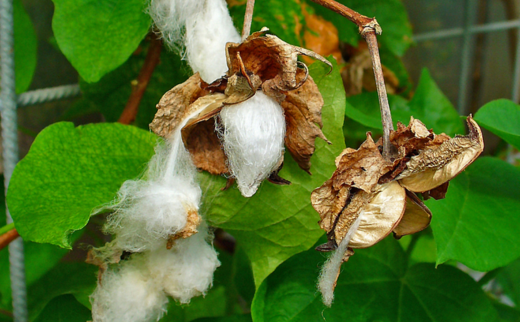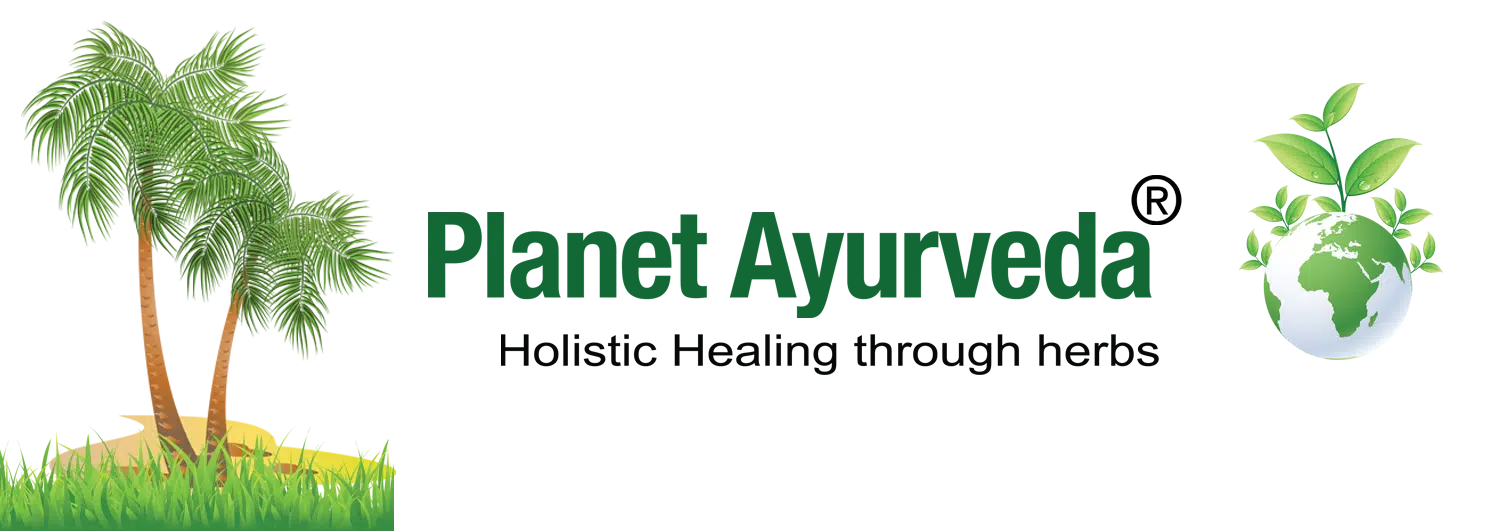Gossypium herbaceum Linn./ Cotton Plant/ Indian Cotton – Ayurvedic Uses & Benefits
Abstract
Gossypium herbaceum Linn, commonly known as the cotton plant, belongs to the Malvaceae family and holds a significant place in traditional medicinal systems, especially Ayurveda and Unani. It is widely distributed across western India, Africa, the Middle East, Central Asia, and parts of Iran, Afghanistan, and Russia. Phytochemical analysis reveals the presence of carbohydrates, saponins, steroids, glycosides, tannins, flavonoids, and the key pigment gossypol. Indian cottonseed oil contains beneficial components like sitosterol, lipids, and essential fatty acids. Traditionally, the plant is used to manage conditions like asthma, dysmenorrhea, lactation issues, diabetes, and skin disorders due to its antifertility, galactagogue, antidiabetic, and antibacterial properties.

Introduction
Gossypium herbaceum is one of the earliest cultivated species of cotton, belonging to the Malvaceae family. Apart from its economic significance in the textile industry, it has long been revered in Ayurvedic and traditional medicine systems for its curative properties. The genus Gossypium is one of the most prominent within the tribe Gossypioideae, comprising around 50 known species, with new ones still being discovered. Its origin dates back approximately 5 to 10 million years. The name Gossypium is derived from the Arabic word “goz,” meaning a soft substance. The English word “cotton” originates from the Arabic term “al qutn,” which evolved into “algodón” in Spanish and eventually became “cotton” in English. Cotton was first domesticated in the Old World nearly 7,000 years ago. India is considered its native land, with many indigenous varieties found across the region. A notable early reference to Gossypium herbaceum comes from the Greek historian Herodotus in the 5th century BCE. The plant was later introduced and cultivated in China around 600 AD. Today, it is primarily grown for its fibers, which are widely used in the textile and clothing industries.
Scientific Classification
- Kingdom: Plantae
- Subkingdom: Tracheobionta
- Division: Magnoliophyta
- Class: Magnoliopsida
- Order: Malvales
- Family: Malvaceae
- Genus: Gossypium
- Species: Gossypium herbaceum L.
Synonyms
- Karpasi
- Tundkeshi
- Samdranta – Cotton prepared is stored in pots for export
- Marudbhava – Cultivated in dry and arid regions
- Vatya – Serves as a primary source of clothing
- Tuntikeri – Known for its round fruit structure
Vernacular Names
- Sanskrit – Tundakeshi
- Assamese – Karpasa, Tula
- Bengali – Bona, Kapasia
- English – Cotton plant seed, Levant cotton, Maltese cotton, Short-staple cotton
- Gujarati – Kapasa
- Hindi – Kapasa, Binaula
- Kannada – Hati, Arale
- Kashmiri – Kath
- Malayalam – Karpasi, Panji Karpasam
- Marathi – Sarki
- Punjabi – Lodhar
- Tamil – Parutti kkoottam
- Telugu – Patti ginga
- Urdu – Pambadana, Habb-ul-Qutn
- Chinese – Cao mian
- French – Cotonnier d’Asie, Cotonnier herbacé
- German – Gewöhnliche Baumwolle, Krautiger Baumwollstrauch
- Japanese – Shiro-bana-wata
- Portuguese – Algodoeiro-asiático
- Spanish – Algodonero, Algodonero herbáceo
- Swedish – Indisk bomull
Habitat
Gossypium herbaceum is believed to have originated in southern Africa but was first domesticated in Arabia. From there, its cultivated forms spread westward into Africa and eastward into India. Today, the plant is widely cultivated across various continents, including Africa, Asia, and the New World. In Africa, it is found in countries like Swaziland, Botswana, Namibia, and South Africa. In Asia, it grows in regions such as China, Pakistan, Nepal, Tajikistan, Turkmenistan, Uzbekistan, Afghanistan, India, Iraq, and Iran. Additionally, it is present in parts of Europe, Central America, and the Caribbean.
Morphology
Gossypium herbaceum is an annual or perennial shrub or subshrub that can grow up to 3 meters tall, with a thick, rigid stem and few branches, which may be either hairy or glabrous. Its leaves are spirally arranged, with small, deciduous stipules, a petiole measuring 2–3.5 cm, and 3–7 shallow lobes. The upper leaf surface is nearly hairless, while the underside is covered with stellate hairs. Flowers are solitary, typically borne on sympodial branches, with a 7–30 mm long unjointed pedicel and three prominent epicalyx bracteoles having toothed margins. The corolla is yellow or white with a dark centre, composed of five petals measuring 2.5–5 cm in length. Stamens are numerous, with short filaments and one-celled anthers, while the pistil contains a 3–to 5-celled ovary. The plant produces a rounded, beaked capsule 2–3.5 cm long, containing ovoid seeds densely covered in long, white, woolly hairs that adhere tightly to the seed.
Varieties
Gossypium herbaceum has many varieties. Here are some of the varieties according to their location:
- Gossypium arboreum Linn. – It is also known as Udyan Karpas. This is a type of cotton that is usually planted in gardens. Its plants are perennial. Its leaves and fruits are slightly large and the flowers are red in colour.
- Gossypium barbadense Linn.
- Gossypium hirstum Linn.
Special Note
There is another variety which is usually found in forests, and this variety is known as Arnaya Karpas (Thespesia lampas Dalz & Gibs). Its shrubs are bushy and hardy. Its leaves are palm-shaped, having 3 or more segments and have a diameter of 10-12.5 cm. Its flowers are yellow and red from the middle part. Its cotton is slightly yellowish.
Classical Categorisation
- According to Charaka Samhita – Brimhaneeya – Strength and bulk-promoting group of herbs
- According to Sushruta Samhita – Vata Samshamana – Vata-pacifying group of herbs
- According to Bhavprakash Nighantu – Guduchyadi Varga
- According to Raj Nighantu – Shatahvadi Varga
Ancient Verses
Verse 1
कार्पासकी लघु कोष्णा मधुरा वातनाशिनी ॥
(Bhavprakash Nighantu Guduchyadi varga 150)
According to the Above shloka, Kapas/ cotton is light, slightly hot in potency and contains a sweet taste. It helps in balancing vitiated vata dosha.
Verse 2
तत्पलाशं समीरघ्नं रक्तकृन्मूत्रवर्द्धनम् ।
तत्कर्णपिडकानादपूयास्त्रावविनाशनम् ॥
तद्बीजं स्तन्यदं वृष्यं स्निग्धं कफकरं गुरु ॥
(Bhavprakash Nighantu Guduchyadi varga 151-152)
According to the above shloka, the leaves of the cotton plant help in balancing Vata dosha. These are effective in the management of boils or pimples in the ear, tinnitus, and purulent discharge from the ear, and they also enhance the blood and urine. The seeds of the cotton plant increase milk production, are aphrodisiac, are unctuous, increase kapha dosha and are heavy in digestion.
Ayurvedic Properties
- Taste (Rasa) – Sweet (Madhur), Pungent (Katu)
- Physical property (Guna) – Light (Laghu), Seeds: Heavy (Guru), Unctuous (Snigdha)
- Potency (Veerya) – Slight Hot Potency (Usna)
- Post-digestion effect (Vipaka) – Katu (Pungent)
- Effect on tridosha – Balance Vata dosha
Therapeutic Properties
- Vatanashini – Relieves Vata disorders – neuralgia, paralysis, constipation, bloating
- Galactagogue – Enhances lactation
- Antifatigue – Reduces tiredness (Shrama)
- Neuroprotective – Helps in dizziness (Bhranti), fainting (Murcha)
- Cardiotonic – Strengthens the heart
- Analgesic – Treats earache (Karnapeeda), tinnitus (Nada)
- Antiseptic – Heals pus-filled wounds (Puyasrava)
- Thirst-reliever – Manages excessive thirst (Trushna)
- Pitta-pacifying – Eases burning sensation (Daha)
Systemic Actions
External Use
Acts as an analgesic and supports wound healing. Seed paste is applied externally for inflammatory conditions, burns, wounds, and poisoning caused by animals or plants. Seed oil is beneficial in relieving joint pain and headaches. Leaf juice is useful as ear drops in various ear ailments.
Internal Uses
- Nervous System – Seeds function as a nervine tonic and are recommended in conditions like epilepsy and insanity. Flowers stimulate the nervous system while also having a calming effect. A flower infusion is helpful in managing mental health disorders.
- Digestive System – Seeds aid in relieving constipation due to their purgative effect. Leaf juice is also beneficial in treating constipation. Flower infusions are used for jaundice and liver-related conditions, and leaves act as a liver stimulant.
- Excretory System – Both leaf juice and seed powder are useful in managing dysuria (painful or difficult urination).
- Reproductive System – Root bark powder or its decoction is effective in treating amenorrhea and dysmenorrhea. It also promotes uterine contractions and is beneficial in postpartum care. Seeds act as an aphrodisiac and enhance lactation in nursing mothers.
- Satmikarana (Rejuvenation and Restoration) – Seeds are used in managing general weakness and animal poisoning. Leaf juice is suitable for anaemic individuals. A hot infusion of seeds and flowers is beneficial in cases of datura poisoning.
- Tapakrama (Fever Management) – Hot seed infusion is recommended as a preventive remedy against fever.
Chemical Composition
1. Seeds Contain
- Steroids
- Flavonoids (Quercetin)
- Proteins
- Amino acids
- Sugars
- Saponins
- Gossypol (main pigment; phenolic compound)
- Gossypupurin
- Gossyfulvin
- Gossycaerulin
- Carotenoids
- Flavones
2. Roots Contain
- Hemigosypol
- Starch
- Tannins
- Phenols
- Saponins
- Carbohydrates
3. Gossypol Details
- Molecular formula: C₃₀H₃₀O₈
- Molecular weight: 518.55 Dalton
- Yellow, crystalline pigment
- Insoluble in water and hexane
- Soluble in acetone, chloroform, ether, methyl ethyl ketone
- Exists in two enantiomers: (−) and (+) gossypol
- Found in free and bound forms
- Total concentration: 0.02–6.64%, can exceed 14,000 mg/kg in seeds
4. Unsaponifiable Fraction Of Seed Oil Contains
- Sitosterol
- Ergosterol
- Lactic acid
- Choline
- Betaine
- Sulphydryl compounds
5. Essential Oil Components
- Caryophyllene
- Pinene
- Limonene
Modern Overview
1. Galactagogue Effect
Gossypol, a polyphenolic compound present in the root bark and seeds of Gossypium herbaceum, has traditionally been used to promote lactation in postpartum women. It is believed to act as a galactagogue by enhancing the secretion or activity of prolactin, the hormone primarily responsible for initiating and maintaining breast milk production. Gossypol may influence the pituitary gland, which regulates prolactin release, thereby stimulating the mammary glands. Additionally, the presence of phytoactive compounds in cotton seeds may support hormonal balance and improve uterine tone, both of which can indirectly support lactation during the postpartum period. However, because gossypol can accumulate in the body and has known side effects—such as interference with potassium and immune cell levels—its use must be carefully dosed and supervised by a qualified practitioner to ensure both maternal and infant safety.
2. Diuretic Activity
Gossypium herbaceum, believed to contribute significantly to its diuretic activity, contains quercetin, a well-known flavonoid. Quercetin promotes diuresis by modulating renal function, primarily through its antioxidant and anti-inflammatory actions. It enhances renal blood flow and may influence the expression of transporters involved in sodium and water reabsorption in the kidneys, leading to increased excretion of urine and electrolytes like sodium and potassium. Additionally, quercetin inhibits the enzyme angiotensin-converting enzyme (ACE), which plays a role in fluid retention and blood pressure regulation. By disrupting this pathway, it facilitates the removal of excess fluids from the body. Thus, the presence of quercetin in Gossypium herbaceum leaf extracts plays a vital role in enhancing urinary output and supporting renal health.
Practical Uses
1. Seeds
- Decoction used as a nervine tonic for headaches and brain-related disorders.
- Seed decoction is effective in treating dysentery and intermittent fever.
- Emulsified seeds are given orally in dysentery.
- Pounded seeds mixed with ginger and water are applied externally for orchitis.
- Seed poultice is applied to burns and scalds for soothing and healing.
- Cotton seed oil helps clear skin blemishes, spots, and freckles.
2. Leaves
- Leaf juice is beneficial in managing dysentery.
- Leaf poultice accelerates the maturation of boils.
- Leaves mixed with oil are applied to gouty joints as a plaster.
- Leaves of Gossypium herbaceum and Bambusa arundinacea are given orally to induce abortion.
- Leaves are administered orally in cases of retained placenta.
3. Roots
- Decoction of the root is given orally in the retention of the placenta.
Part Used
- Roots
- Bark
- Flowers
- Seed
Dosage
- Seed powder – 3–6 gms
- Root bark powder – 2–4 gms
- Decoction – 50–100 ml
Planet Ayurveda Medicines
Conclusion
Gossypium herbaceum is a multifaceted medicinal plant with applications in both traditional healing and modern herbal medicine. Its value extends beyond fiber production, offering significant therapeutic benefits, particularly in women’s health, wound management, and inflammation control. Rich in bioactive compounds, the plant has been traditionally used across Indian households and is now receiving increased attention from researchers. When used appropriately and under supervision, it serves as a potent remedy for various chronic and acute conditions, affirming its place in Ayurveda and ethnomedicine.



